A COSMIC SCALE
UNMASKS
''THIN-LOOKING FAT'' STARS
A COSMIC SCALE
UNMASKS
''THIN-LOOKING FAT'' STARS
A few heavy stars generated by stellar interactions are hidden in the core of ancient stellar systems made of millions lighter stars (with masses lower than that of our Sun). A team of researchers of the Bologna University (Italy), in collaboration with INAF, has proposed a "cosmic scale" able to unmask these elusive thin-looking fat stars.
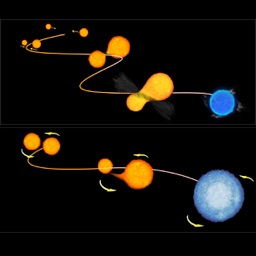
This illustration shows how Blue Straggler Stars become heavier than normal cluster stars: they are the result of stellar collisions (upper panel) or vampirism phenomena between two companion stars (lower panel).
For any additional information please contact
Francesco Ferraro
email: francesco.ferraro3@unibo.it
tel: +390512095774
mobile: +393666357560


The discovery of the cosmic scale is another major result obtained within Cosmic-Lab, a 5-year Advanced Grant project funded with 1.8 million euros by the European Research Council, specifically designed to probe the complex dynamical phenomena occurring into the congested regions characterizing star clusters. "Thanks to this grant we have grown a team of prepared and motivated (young) researchers, and the results are coming! This discovery represents a major success for the Italian and the European astrophysical community and suggests that we are on the right track not only to open new perspectives to the astrophysical knowledge, but also to provide a fruitful breeding ground for the formation of young scientists with a broad view in Physics and Astrophysics. This project is contributing to create a top-level research centre for stellar Astrophysics at the Bologna University, that will be a reference for young students, not only in Italy, but also in Europe and all over the world", concludes Ferraro.
The new tool has been designed by a team of researchers of the Department of Physics and Astronomy of the University of Bologna (UniBO), led by Prof. Francesco Ferraro. This is a new result of the five-year project Cosmic-Lab funded by the European Research Council. By using this innovative "cosmic scale", the mass of stars (a key parameter driving the entire stellar evolution) can be measured and an evolved Blue Straggler Star has been unmasked in the globular cluster 47 Tucanae.
Globular clusters (GCs) are old stellar aggregates composed of up to a few million stars formed approximately at the same epoch (about 13 billion years ago). Because of their age and since no recent star formation occurred, all stars more massive than 0.8-0.9 Msol in GCs should have already concluded their life-cycle, ending as white dwarfs, neutron stars, or black holes. At odds with such a prediction, a peculiar population of heavy stars (1.2-1.6 Msol) still evolving in the very early phases of their life-cycle are observed in GCs: these are the so-called Blue Straggler Stars (BSSs).
To try and explain the existence of these objects, astronomers hypothesise that they formed through mass-enhancement processes (possibly involving stellar collisions and mass transfer in binary systems). However, these mechanisms are not completely understood yet, and essentially nothing is known to date about the advanced stages of BSS evolution.
"Indeed the mass of stars is the key parameter in stellar Astrophysics: it drives the entire evolution of stars (from birth to death)." explains Prof. Ferraro of UniBO, who led the research "Broadly speaking, the life of massive stars is much shorter than that of low-mass stars. This is the reason why, in GCs, we do not expect to observe stars as massive as BSSs in early stages of their life. Unfortunately, defining methods for measuring stellar masses is quite difficult in general. Our discovery demonstrates that the detailed comparison between chemical abundances derived from neutral and from ionized elements is a powerful cosmic scale, which we used to identify a more massive star (an evolved BSS) in the see of its (otherwise indistinguishable) sisters."
"The approach is quite powerful since it allows to accurately estimate mass differences of any star (independently of it being "normal" or "peculiar"), thus minimizing the uncertainties and possible zero- point offsets due to the use of different methods" adds Emilio Lapenna from UniBO.
"Although this is not the very first identification of an evolved-BSS in a GC" continues Ferraro "the discovery provides the long-sought tool enabling systematic searches for these objects in GCs, thus giving access to still unexplored phases of BSS evolution."
"Indeed, since evolved-BSSs are 20 times more luminous than their progenitors, detailed spectroscopic follow-up studies are largely facilitated and open the possibility to even go back to the formation channel. In fact, a few characterizing features impressed by the formation process could be still observable in such advanced stages of the evolution" adds Alessio Mucciarelli from UniBO.
"Thanks to future measurements by means of the cosmic scale, predictions from both the collisional and
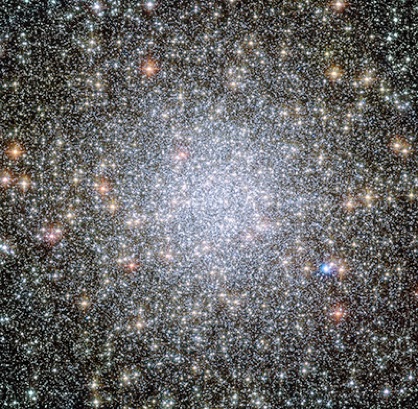
47 Tucanae seen by the Hubble Space Telescope
This globular cluster is located in the constellation Tucana, 15 thousand light-years from Earth and it is one of the richest stellar clusters in the Milky Way. It has a diameter of 120 light-years and it is composed of about one million stars with masses lower than that of our Sun. Astronomers believe that more than 4 thousand stars are contained within the nucleus of this cluster, in a volume of just 1 light-year. 47 Tucanae can be observed with naked-eye from the Southern emisphere, where it appears as a diffuse nebula with an extension on the sky similar to that of the Moon.
"The basic idea is quite simple" continues Ferraro "the abundance of a given chemical element obtained from the absorption lines of ionized atoms sensitively depends on stellar mass, while such a dependence is negligible for neutral spectral features of the same element. Since the abundances obtained from the two measurements must agree, the difference between the two values can be used to derive the stellar mass. Indeed, the difference between the two abundances (derived from neutral and from ionized species) can be used as the pointer of a cosmic scale: when the correct stellar mass is assumed, the pointer marks zero."
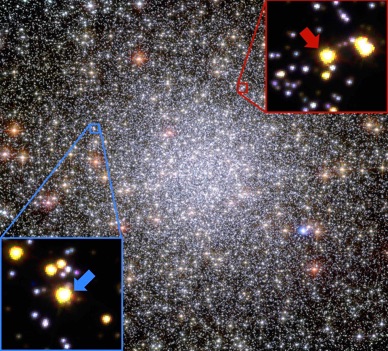
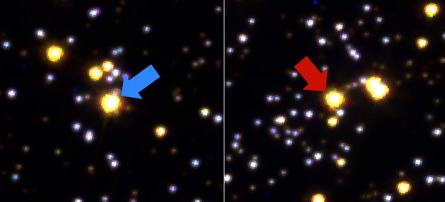
Two of the stars "weighed" with the cosmic scale
The cosmic scale revealed that the star on the left (indicated with the blue arrow) has a mass as twice as large than that on the right (red arrow), although its colour and luminosity are indistinguishable, and very similar also to those of the other stars in the cluster.
The observations that allowed the discovery of the cosmic scale have been performed with the UVES-FLAMES spectrograph installed at the Very Large Telescope (VLT) of the European Southern Observatory (ESO), on the top of Cerro Paranal, in the north of Chile. The data have been acquired in the context of a much wider project (an ESO Large Programme, led by Prof. Ferraro) that aims at determining the radial velocities and chemical abundances of hundreds stars in a sample of about 30 GCs of our galaxy. The telescope time (almost 200 hours) has been assigned to the project via a highly competitve international selection.
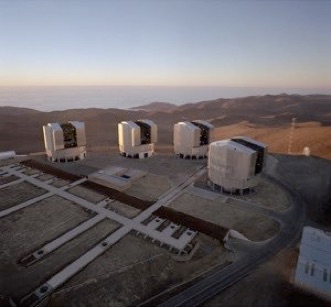

The ESO Very Large Telescope
The four telescopes, each with a 8.2m diameter mirror, are located on the top of Cerro Paranal, in Chile.

This is because, while BSSs can be easily identified during their core hydrogen-burning phase (when they appear brighter and bluer than the normal cluster stars), they are completely indistinguishable (in terms of luminosity and colour) from their low-mass sisters during the advanced stages of the subsequent evolution.
Thanks to the proposed cosmic scale, the team of astronomers has been able to distinguish one evolved BSS (with a mass of 1.4 Msol) in the multitude of its low-mass sisters in the globular cluster 47 Tucanae.
the mass transfer formation scenarios can be verified, thus opening a new perspective on our comprehension of BSS evolutionary paths and formation processes" concludes Barbara Lanzoni from UniBO.